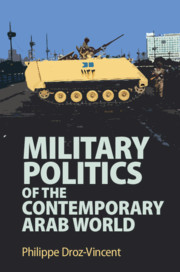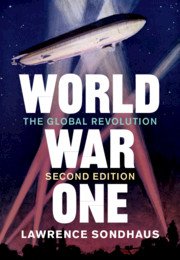Refine search
Actions for selected content:
15418 results in Military history
Contents
-
- Book:
- Pulp Vietnam
- Published online:
- 22 October 2020
- Print publication:
- 22 October 2020, pp vii-viii
-
- Chapter
- Export citation
Conclusion: Male Veterans Remember Their War
-
- Book:
- Pulp Vietnam
- Published online:
- 22 October 2020
- Print publication:
- 22 October 2020, pp 218-238
-
- Chapter
- Export citation
Index
-
- Book:
- Pulp Vietnam
- Published online:
- 22 October 2020
- Print publication:
- 22 October 2020, pp 335-364
-
- Chapter
- Export citation
Chapter 5 - War and Sexual Violence Come to Vietnam
-
- Book:
- Pulp Vietnam
- Published online:
- 22 October 2020
- Print publication:
- 22 October 2020, pp 174-217
-
- Chapter
- Export citation
Dedication
-
- Book:
- Pulp Vietnam
- Published online:
- 22 October 2020
- Print publication:
- 22 October 2020, pp v-vi
-
- Chapter
- Export citation

Military Politics of the Contemporary Arab World
-
- Published online:
- 16 October 2020
- Print publication:
- 29 October 2020

World War One
- The Global Revolution
-
- Published online:
- 08 October 2020
- Print publication:
- 29 October 2020
-
- Textbook
- Export citation
4 - Byzantium to the twelfth century
- from Part I - Foundations, c.600–1000 ce
-
-
- Book:
- The Cambridge History of War
- Published online:
- 25 September 2020
- Print publication:
- 01 October 2020, pp 107-132
-
- Chapter
- Export citation
23 - Land technologies
- from Part IV - Comparisons: Cross-Cultural Analysis
-
-
- Book:
- The Cambridge History of War
- Published online:
- 25 September 2020
- Print publication:
- 01 October 2020, pp 640-661
-
- Chapter
- Export citation
15 - The reconquest and the Spanish monarchies
- from Part III - Nations and Formations, c.1300–1500 ce
-
-
- Book:
- The Cambridge History of War
- Published online:
- 25 September 2020
- Print publication:
- 01 October 2020, pp 409-428
-
- Chapter
- Export citation
Introduction to volume II
-
-
- Book:
- The Cambridge History of War
- Published online:
- 25 September 2020
- Print publication:
- 01 October 2020, pp 1-14
-
- Chapter
- Export citation
14 - Warfare and Italian states, 1300–1500
- from Part III - Nations and Formations, c.1300–1500 ce
-
-
- Book:
- The Cambridge History of War
- Published online:
- 25 September 2020
- Print publication:
- 01 October 2020, pp 389-408
-
- Chapter
- Export citation
3 - The Scandinavian world
- from Part I - Foundations, c.600–1000 ce
-
-
- Book:
- The Cambridge History of War
- Published online:
- 25 September 2020
- Print publication:
- 01 October 2020, pp 83-106
-
- Chapter
- Export citation
Index
-
- Book:
- The Cambridge History of War
- Published online:
- 25 September 2020
- Print publication:
- 01 October 2020, pp 720-748
-
- Chapter
- Export citation
7 - China: the Tang, 600–900
- from Part I - Foundations, c.600–1000 ce
-
-
- Book:
- The Cambridge History of War
- Published online:
- 25 September 2020
- Print publication:
- 01 October 2020, pp 181-210
-
- Chapter
- Export citation
18 - India, c.1200–c.1500
- from Part III - Nations and Formations, c.1300–1500 ce
-
-
- Book:
- The Cambridge History of War
- Published online:
- 25 September 2020
- Print publication:
- 01 October 2020, pp 470-506
-
- Chapter
- Export citation
8 - Japan to 1200
- from Part I - Foundations, c.600–1000 ce
-
-
- Book:
- The Cambridge History of War
- Published online:
- 25 September 2020
- Print publication:
- 01 October 2020, pp 211-240
-
- Chapter
- Export citation
Notes on contributors
-
- Book:
- The Cambridge History of War
- Published online:
- 25 September 2020
- Print publication:
- 01 October 2020, pp xi-xiv
-
- Chapter
- Export citation
17 - Ottoman expansion and military power, 1300–1453
- from Part III - Nations and Formations, c.1300–1500 ce
-
-
- Book:
- The Cambridge History of War
- Published online:
- 25 September 2020
- Print publication:
- 01 October 2020, pp 449-469
-
- Chapter
- Export citation
Part IV - Comparisons: Cross-Cultural Analysis
-
- Book:
- The Cambridge History of War
- Published online:
- 25 September 2020
- Print publication:
- 01 October 2020, pp 613-682
-
- Chapter
- Export citation
